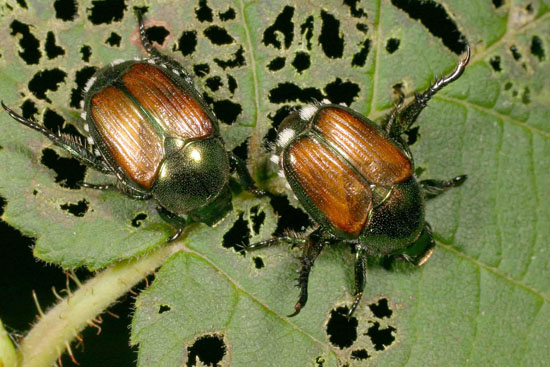Issue 1, April 18, 2011
Japanese Beetle Control
Adult Japanese beetles feed on the upper leaves of crabapple, linden, serviceberry, flowering cherry, birch, willow, rose, and many other trees and shrubs from late June through mid-August. They can defoliate or window-feed at least the upper third of the tree. Window-feeding consists of eating the upper surface and center of the leaf, leaving the lower surface which is whitish and somewhat transparent. The cells of this exposed lower surface soon turn brown. The adult Japanese beetles are three-eighths to one-half inch long and stocky with metallic green bodies and coppery wing covers.

Imidacloprid, sold as Merit and other brand names, moves systemically through the tree into the leaves where it effectively controls the adult beetles. Imidacloprid moves through the tree within about two weeks if trunk injected. When applied to the soil as a soil injection or soil drench, it takes up to eight weeks to move throughout the tree. With the beetles due to emerge in about two months, soil applications should be applied by the end of April. Avoid application of imidacloprid into mulch, thatch, or other dead organic matter as the insecticide adsorbs onto it, making it unavailable for root uptake. Soil inject below the sod or mulch or pull back the sod or mulch to soil drench. Apply within two feet of the trunk.
Imidacloprid remains in the tree for at least a year after application, so application at any time during the growing season is effective as long as there are active leaves on the trees for eight weeks after application. The active leaves are needed to drive the transpiration which moves the imidacloprid throughout the tree.
There is concern about imidacloprid moving into the pollen and nectar of flowers and affecting honey bees and other pollinators. Imidacloprid is known to move into linden flowers, so its use on that tree should be avoided. Wind-pollinated trees, such as birches, are unlikely to be visited by pollinators. Roses with double blossoms are usually not visited by pollinators either, but watch for flower visits by bees or other pollinators before applying imidacloprid. Imidacloprid does not move into crabapple flowers. (Phil Nixon)
Author:
Phil Nixon